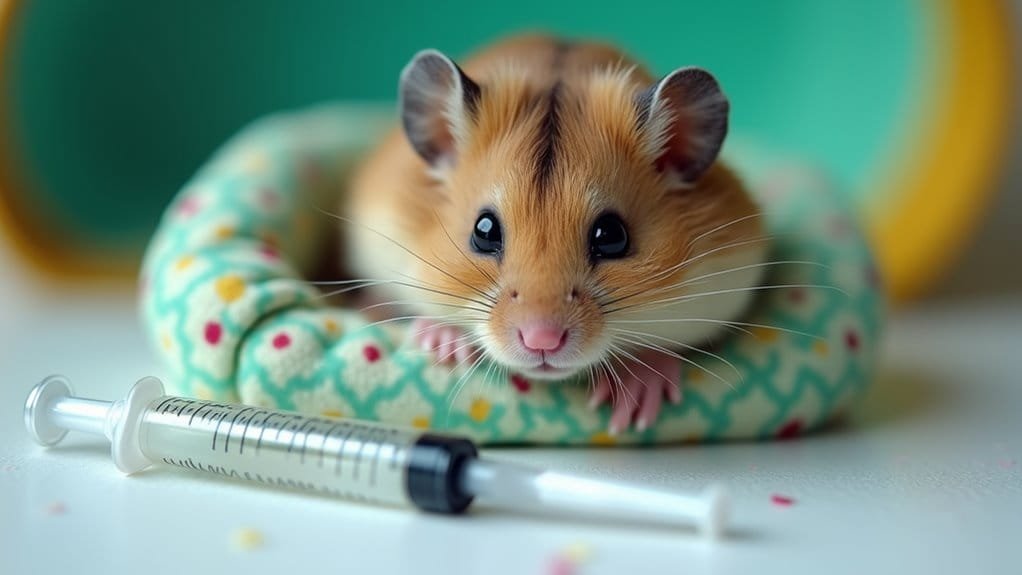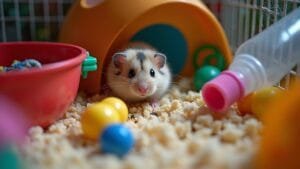So, your hamster might have wet tail, huh? Yikes! This nasty condition can sneak in with symptoms like watery diarrhea, loss of appetite, and a tail that looks like it’s been through a mud puddle. If left untreated, it can be fatal in just a couple of days—scary, right? You’ll need to get to a vet fast for diagnosis and treatment, typically antibiotics and hydration. Plus, keep things clean and stress-free at home, or it might just happen again. Want to prevent your furry buddy from becoming a wet tail statistic? Stick around, and see how!
Understanding Hamster Wet Tail
Wet tail, a serious condition in hamsters, can strike quickly and with devastating effects. Imagine your little furry friend, usually zipping around, suddenly feeling droopy and sad. It’s scary!
This disease, also known as proliferative ileitis, shows up as severe watery diarrhea, making your hamster’s tail and behind look, well, wet—hence the name. If you notice this, don’t wait. You’ve got just 48 to 72 hours before things can get really bad.
Your hamster might also act tired and hunched, like it’s carrying a heavy backpack. You might see it lose interest in treats, even its favorite sunflower seeds. Dirty living environments contribute to the growth of harmful bacteria, which can exacerbate the condition.
And let’s not forget those dull, sad eyes. If you see blood or an unhappy little bottom, it’s time to call the vet!
Causes of Wet Tail
Hamsters often develop wet tail due to a combination of stress, environmental factors, dietary issues, and bacterial infections. You might be wondering, “What exactly causes this yucky situation?” Well, let’s break it down!
Here are some common culprits:
- Stress: Too much handling or changes in their home can freak them out.
- Dirty Environment: Old bedding and leftover food can lead to a messy, unhealthy cage.
- Diet Problems: Giving them too many watery fruits or sudden diet changes can upset their tummies.
- Bacterial Infections: Some nasty bacteria, like *Lawsonia intracellularis*, can cause real trouble.
- Overcrowding: If they’re packed in too tight, it’s a recipe for stress disaster.
Additionally, stress disrupts gut flora balance, which can worsen their condition. Just like you wouldn’t want to live in a messy room, your hamster needs a clean, comfy space to thrive.
Keep an eye on their diet and handling, too. Remember, a happy hamster is a healthy hamster!
Recognizing Symptoms
Recognizing the symptoms of wet tail is key to ensuring your hamster gets the care it needs quickly.
First off, if you notice your little buddy’s lost its appetite, that’s a big red flag. A lethargic hamster isn’t the happy little furball you know and love, right?
Keep an eye out for excessive watery diarrhea, too. It’s like a hamster has turned its tiny tummy into a water fountain—not normal!
You might spot a wet, dirty tail or matted fur around that area. If your hamster’s standing hunched with folded ears, it’s feeling pretty miserable. Syrian hamsters are particularly at risk for developing this condition.
You may even notice dull eyes staring back at you. And hey, if it seems angry or irritable, or it’s writhing around in discomfort, something’s definitely wrong.
A hamster that’s staggering or crying out in pain needs your help fast!
Diagnostic Process
Understanding the diagnostic process is crucial for addressing wet tail in your hamster swiftly. You don’t want to waste time when your furry friend is feeling under the weather! Here’s what you need to know:
- Visit an exotics vet: Only a vet can confirm if it’s wet tail or something else.
- Share your hamster’s history: Tell the vet about any recent changes in diet or environment.
- Look for signs: The vet will check for dehydration, diarrhea, and other symptoms.
- Differentiate causes: It’s important to figure out if it’s wet tail or just a dirty cage.
- Isolate the sick hamster: This helps prevent spreading the illness to others.
Now, diagnosing wet tail isn’t always easy. Diarrhea could be from stress or a new food. Additionally, understanding that proliferative ileitis is a common cause of wet tail can aid in the diagnostic process.
Plus, other health issues might be hiding. But don’t worry, spotting wet tail early makes a big difference!
If you notice signs, rush to get help. Remember, the sooner you act, the better chance your hamster has to bounce back.
Treatment Options
Timely treatment options are essential for managing wet tail in your hamster effectively.
First off, antibiotics are your best friends here! They help fight off nasty bacteria, like *Lawsonia intracellularis*, that cause the illness.
Next, make sure your little furball stays hydrated. Fluid therapy is super important—think of it as giving your hamster a revitalizing drink. If diarrhea gets bad, your vet might suggest anti-diarrheal medications to ease those tummy troubles.
Now, let’s talk about comfort. Your hamster will need a clean, warm, and quiet space to recover. Maintaining sanitary conditions is important to prevent further stress and illness.
Isolation is key; you don’t want to share the germs with other hamsters. If your little buddy refuses to eat, you may need to do some syringe feeding with specialized hamster food or even veggie baby food—yummy, right?
Importance of Prevention
Preventing wet tail in your hamster is crucial for their overall health and well-being.
Nobody wants to deal with a sick pet, right? By taking a few simple steps, you can help keep your furry friend happy and healthy.
Let’s break it down!
- Clean Living Environment: Spot clean daily and deep clean weekly. A tidy home keeps bacteria at bay.
- Proper Diet: Limit treats and guarantee all foods are safe. Think of it as hamster nutrition 101. A poor diet can lead to wet tail.
- Stress Reduction: Handle your hamster gently and keep their space quiet. Stress is a sneaky culprit!
- Health Monitoring: Keep an eye out for signs of wet tail. Catching it early makes a big difference.
- Avoid Sudden Changes: Just like you, hamsters dislike sudden shifts. Stick to their routine!
Home Care Strategies
To effectively care for your hamster at home and reduce the risk of wet tail, it’s essential to implement a series of strategies that focus on cleanliness, diet, and stress management.
First off, keep your hamster’s cage spick and span! Remove old bedding and sawdust every day, and scrub the water bottle and food bowl like they’re your favorite dishes. A deep cleaning once a week will keep things fresh.
Next, let’s talk about what goes into that tiny tummy. Avoid giving your hamster juicy fruits or veggies that could lead to messy diarrhea.
Stick to dry food and always make sure fresh water is available. If your little buddy’s not eating, you might need to get creative with syringe feeding—sounds fun, right?
Prognosis and Fatality Rates
Understanding the prognosis and fatality rates of wet tail in hamsters can help you act quickly if your pet shows symptoms.
Wet tail isn’t just a cute name; it can be really serious. If you notice signs, don’t wait!
Here’s what you need to know:
- Mortality Rate: Wet tail can be fatal, especially for young or old hamsters.
- Quick Action: Early detection and treatment boost survival chances.
- 48-72 Hours: Hamsters can pass away within just a few days if untreated.
- Veterinary Help: Getting your hamster to the vet fast is key to recovery.
- Stress Matters: A calm environment can make a big difference.
Special Considerations for Young Hamsters
Caring for young hamsters requires extra attention, especially when it comes to wet tail, a potentially life-threatening condition. You might think of them as tiny, fluffy bundles of energy, but they need your help to stay healthy. Here are some key symptoms you should watch for:
| Symptom | Description | Why It Matters |
|---|---|---|
| Severe Diarrhea | Watery and bloody output | Indicates serious health issues |
| Lethargy | Lack of energy and reluctance to move | Could signal dehydration |
| Hunched Posture | Physical signs of discomfort | Shows they’re not feeling well |
| Foul Odor | Strong, unpleasant smell | Often linked to wet tail |
| Loss of Appetite | Reduced interest in food | Leads to weight loss |
Young hamsters can get stressed easily. Frequent moves, too much handling, and dirty cages can all contribute to wet tail. Make sure you keep their environment clean and calm. And hey, don’t forget to limit handling—just like us, they need their space! If you see any of these symptoms, take action right away to help your little friend. Remember, a happy hamster is a healthy hamster!
Seeking Veterinary Assistance
Recognizing the urgency of wet tail symptoms is vital for your hamster’s survival. If you notice any signs, don’t wait! Time is of the essence here, and your furry friend needs you to act fast. Without treatment, hamsters can go downhill in just 48 hours. Scary, right?
Here’s what to look out for:
- Diarrhea or wetness around the tail
- Lethargy or weakness
- Loss of appetite
- Hunched posture or abnormal behavior
- Dehydration signs, like sunken eyes
As soon as you see these symptoms, head to the vet. They’ll check your hamster thoroughly, possibly running tests to figure out what’s really going on. You might get prescribed antibiotics or anti-diarrheal meds—don’t worry; this is common.
And guess what? They might even suggest a cozy, quiet space for recovery.
It’s super important to get a professional diagnosis because wet tail can look like other illnesses. You wouldn’t want to treat the wrong thing!




